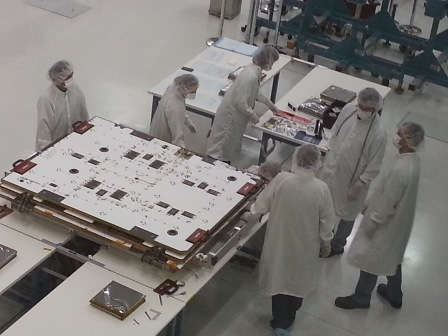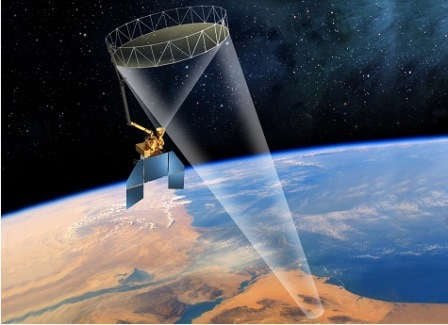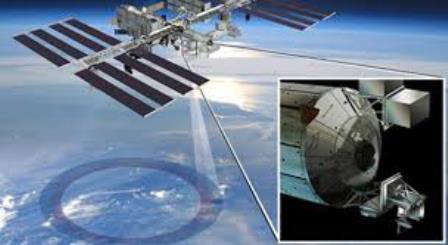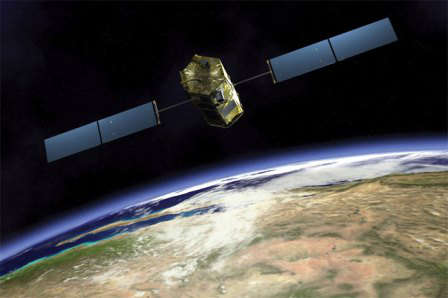As mentioned in an previous post, earlier this month I joined 99 other space enthusiasts to visit NASA's Jet Propulsion Laboratory in Pasadena, CA. The NASA Jet Propulsion Laboratory (JPL) is a federally funded research and development center and is managed by the California Institute of Technology for the National Aeronautics and Space Administration. JPL has a core focus on planetary exploration, Earth science, astronomy and physics.
The focus last week was primarily on Earth science, although we did get to tour the Mars Yard and visit Mission Control, as well! In 2014, JPL will launch three missions to study the Earth and its climate. These missions were the centerpiece to JPL's recent Earth Now NASA Social event. The three Earth-observing missions are:
- Soil Moisture Active Passive (SMAP) spacecraft,
- ISS-RapidScat, and
- Orbiting Carbon Observatory-2 (OCO-2).
Both the SMAP and the ISS-RapidScat are being assembled at JPL.
NASA project team members working on the SMAP solar panels during our visit
We were fortunate enough to see theSMAP assembly in progress (see artist's rending of SMAP in action below). The SMAP will be a dedicated spacecraft that will provide soil measurements regarding moisture and its freeze/thaw state. This data will be collected through circular scans of strips of data which slowly piece together a comprehensive picture of where the moisture is held. The “brain” of SMAP is only about the size of a large refrigerator and is accompanied by large solar panels and a large, round mesh antenna (about 6 meters in diameter) shared by the radar and radiometer.
SMAP or Soil Moisture Active Passive
The SMAP spacecraft will help us understand “the water, energy and carbon cycles and to extend the capabilities of weather and climate prediction models.” 1 The measurements will be acquired for three years and then validated. As is de rigueur for NASA, data will then be made available to the public. The ISS-RapidScat will be replacing the QuickScat Earth satellite to measure the ocean's surface wind speed and direction. NASA will be re-using parts from past mission preparations to accelerate the production of this spacecraft. One challenge they encountered was that they needed to retro-fit protocols to the ISS protocols since it wasn't designed for external experiments. After 15 years in storage, all of the modules powered up and so they reused them. The ISS-RapidScat has been made “on the cheap” for only $26M in comparison to $400M for the same mission from scratch. Through hardware reuse and by utilizing the framework of the International Space Station, NASA has been able to cut costs and time in comparison to creating a new satellite.
ISS-RapidScat
The work that the ISS-RapidScat will do regarding measuring the ocean winds is intrinsic to weather forecasts, including hurricane monitoring. The ocean stores energy, heat and gasses. The reason why we are so concerned about the ocean winds is best summed up by Ernesto Rodriguez, Project Scientist at NASA, in a memorable analogy:
“We really live in the water planet and the ocean is like a huge flywheel. It stores all the kinetic energy, the motion energy. It also stores a lot of our heat…the ocean doesn't freeze all the way through and the reason that happens is because it has all that heat. It also stores a lot of the gasses we put out, all the CO2. If the ocean were not there, right now we'd be close to Venus.
[W]hat's powering this flywheel? Think of the winds as a bunch of unruly mice. Going around and making the flywheel run around. [R]eally understanding these unruly mice is what we're trying to do, in a global sense. They're interesting mice because just like regular mice, they're affected by the sun. So when the sun comes up, they have energy, they start to get energy through the day and [the winds] start to blow. They blow in different ways during the time of day, as they blow in different parts of the ocean they start to extract water vapor that forms clouds. The clouds reflect the energy back into space and that keeps us cool. It also rains, so it takes water from one place to the other.
But think about the problem of trying to monitor these unruly mice globally. The problem we have right now is that because they are affected by the sun…they have breakfast, they get going, then they get tired, then they go to sleep. Right now we have a bunch of satellites that are only able to take snapshots during breakfast, during lunch or at night. [T]here's no way that we have to put them together. So, the Space Station is really cool in the sense that it has an orbit that, throughout the period of a year, will allow it to visit all places on the Earth at different times. So we'll be able to look at the mice at all times during their daily cycle and also to be able to tie all these other satellites that are going on at the same time and being able to bring them together because right now they are telling us different things. [W]e don't know how to put it together, so it's a recycled mission, but the science it can do is really, really cool!”
In a sad twist of irony, at the same time we were learning about the impact NASA's tools have in our understanding of Earth and our weather patterns, Typhoon Haiyan was approaching the Philippines. In the future, perhaps, we'll be better able to predict earlier when and where such violent storms may occur and take precautionary actions to save more lives.
“The Orbiting Carbon Observatory-2 (OCO-2) is scheduled to launch in July 2014 and is currently in final assembly and testing at an Orbital Sciences Corp. facility in Gilbert, AZ. OCO-2 will be NASA's first dedicated Earth remote sensing satellite to study atmospheric carbon dioxide from space.” 2 This spacecraft will measure and study atmospheric carbon dioxide (CO 2) on a global scale from space.
Orbiting Carbon Observitory-2
Fascinating as it is, half of the CO 2 that we've created through burning is still in the atmosphere, yet Earth continues to pull out about half of what we continue to produce even as we increase our burning amounts. Overall, CO 2 can be considered Earth's breathing cycle. It cycles through seasons of high, then low levels. The overall trend, however is clearly upwards which is concerning since CO 2 is one of the gasses that traps heat near the surface of Earth and impacts the Earth's climate.
At the end of the first two-hour session, several of us were walking around in a bit of a daze, complaining of our brains exploding under the intensity of the experience coupled with the dense and fascinating subject matter. The 50+ volunteers and staff at JPL went out of their way to make the information accessible, available, and to answer any questions that we had. It was an intensely satisfying experience to learn about a much overlooked aspect of our space program.
Read more about visiting NASA JPL:
NASA Jet Propulsion Laboratory or Bust!
The Ultimate in Recycling: Parts and Ideas
Sources









